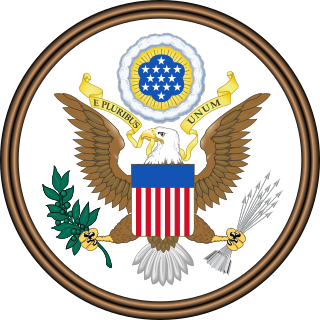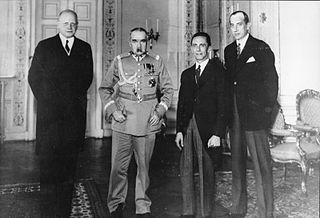
Czechoslovakia, or Czecho-Slovakia, was a sovereign state in Central Europe, created in October 1918, when it declared its independence from Austria-Hungary.

The Munich Agreement was an agreement concluded at Munich on 30 September 1938, by Germany, the United Kingdom, the French Third Republic, and the Kingdom of Italy. It provided "cession to Germany of the Sudeten German territory" of Czechoslovakia, despite the existence of the 1924 alliance agreement and 1925 military pact between France and the Czechoslovak Republic, for which it is also known also as the Munich Betrayal. Most of Europe celebrated the Munich agreement, which was presented as a way to prevent a major war on the continent. The four powers agreed to the annexation of the Czechoslovak borderland areas named the Sudetenland, where more than 3 million people, mainly ethnic Germans, lived. Hitler announced it was his last territorial claim in Europe.
The Treaty of London or London Convention or similar may refer to:
Forward is a relative direction, the opposite of backward.

The Trading with the Enemy Act (TWEA) of 1917 is a United States federal law, enacted on October 6, 1917, that gives the President of the United States the power to oversee or restrict any and all trade between the United States and its enemies in times of war. TWEA was amended in 1933 by the Emergency Banking Act to extend the president’s authority also in peace time. It was amended again in 1977 by the International Emergency Economic Powers Act (IEEPA) to restrict the application of TWEA only in times of war, while the IEEPA was intended to be used in peace time.
The First Czechoslovak Republic emerged from the collapse of the Austro-Hungarian Empire in October 1918. The new state consisted mostly of territories inhabited by Czechs and Slovaks, but also included areas containing majority populations of other nationalities, particularly Germans (22.95 %), who accounted for more citizens than the state's second state nation of the Slovaks, Hungarians (5.47 %) and Ruthenians (3.39 %). The new state comprised the total of Bohemia whose borders did not coincide with the language border between German and Czech. Despite initially developing effective representative institutions alongside a successful economy, the deteriorating international economic situation in the 1930s gave rise to growing ethnic tensions. The dispute between the Czech and German populations, fanned by the rise of National Socialism in neighbouring Germany, resulted in the loss of territory under the terms of the Munich Agreement and subsequent events in the autumn of 1938, bringing about the end of the First Republic.

The German occupation of Czechoslovakia (1938–1945) began with the German annexation of the Sudetenland in 1938, continued with the March 1939 invasion of the Czech lands and creation of the Protectorate of Bohemia and Moravia, and by the end of 1944 extended to all parts of the former Czechoslovakia.

The First Vienna Award was a treaty signed on November 2, 1938, as a result of the Vienna Arbitration. The Arbitration took place at Vienna's Belvedere Palace. The Arbitration and Award were direct consequences of the Munich Agreement the previous month and decided the partitioning of Czechoslovakia.

Border conflicts between Poland and Czechoslovakia began in 1918 between the Second Polish Republic and First Czechoslovak Republic, both freshly created states. The conflicts centered on the disputed areas of Cieszyn Silesia, Orava Territory and Spiš. After World War II they broadened to include areas around the cities of Kłodzko and Racibórz, which until 1945 had belonged to Germany. The conflicts became critical in 1919 and were finally settled in 1958 in a treaty between the Polish People's Republic and the Czechoslovak Socialist Republic.

The Decrees of the President of the Republic and the Constitutional Decrees of the President of the Republic, commonly known as the Beneš decrees, were a series of laws drafted by the Czechoslovak government-in-exile in the absence of the Czechoslovak parliament during the German occupation of Czechoslovakia in World War II. They were issued by President Edvard Beneš from 21 July 1940 to 27 October 1945 and retroactively ratified by the Interim National Assembly of Czechoslovakia on 6 March 1946.
London Protocol can refer to one of many treaties signed in London, England:

The German–Polish declaration of non-aggression, also known as the German–Polish non-aggression pact, was a non-aggression agreement between Nazi Germany and the Second Polish Republic that was signed on 26 January 1934 in Berlin. Both countries pledged to resolve their problems by bilateral negotiations and to forgo armed conflict for a period of 10 years. The agreement effectively normalised relations between Poland and Germany, which had been strained by border disputes arising from the territorial settlement in the Treaty of Versailles. Germany effectively recognised Poland's borders and moved to end an economically-damaging customs war between the two countries that had taken place over the previous decade.
Berlin Declaration may refer to one of the following declarations:

The expulsion of Germans from Czechoslovakia after World War II was part of a series of evacuations and deportations of Germans from Central and Eastern Europe during and after World War II.

During World War II, the Soviet Union occupied and annexed several countries effectively handed over by Nazi Germany in the secret Molotov–Ribbentrop Pact of 1939. These included the eastern regions of Poland, as well as Latvia, Estonia, Lithuania, part of eastern Finland and eastern Romania. Apart from the Molotov–Ribbentrop Pact and post-war division of Germany, the USSR also occupied and annexed Carpathian Ruthenia from Czechoslovakia in 1945.

The Czechoslovak government-in-exile, sometimes styled officially as the Provisional Government of Czechoslovakia, was an informal title conferred upon the Czechoslovak National Liberation Committee, initially by British diplomatic recognition. The name came to be used by other World War II Allies as they subsequently recognised it. The committee was originally created by the former Czechoslovak President, Edvard Beneš in Paris, France, in October 1939. Unsuccessful negotiations with France for diplomatic status, as well as the impending Nazi occupation of France, forced the committee to withdraw to London in 1940. The Czechoslovak Government-in-Exile offices were at various locations in London but mainly at a building called Fursecroft.
Washington Agreement or Washington Accords may refer to:

Czech–German relations date back some 1,500 years. Today, the two countries share 815 km of common borders. The Czech Republic has an embassy in Berlin, 3 general consulates, and 6 honorary consulates. Germany has an embassy in Prague. Both countries are full members of NATO and of the European Union.
The Convention of Saint Petersburg may refer to several diplomatic agreements including
The Washington Principles on Nazi-Confiscated Art, formally the Washington Conference Principles on Nazi-Confiscated Art and sometimes referred to as the Washington Declaration is a statement concerning the restitution of art confiscated by the Nazi regime in Germany before and during World War II. It was released in connection with the Washington Conference on Holocaust Era Assets, held in Washington, D.C., United States, on 3 December 1998.










